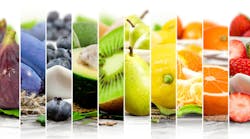According to International Food Information Council’s (IFIC) 2022 Food and Health Survey, preference for products labeled as “natural” and “clean” has increased in 2022.
Of the 1,005 respondents to the survey, 39% said they regularly buy products labeled as "natural," and 27% said so for "clean ingredients." Interestingly, some 36% said one reason for seeking “natural” food and beverages was that “they were better for the environment.” The online survey was conducted among Americans between March 23 and April 4.
The number of Americans following a diet or eating pattern in the past year jumped to 52% compared to only 38% to 43% saying so in the three previous years. The most common eating pattern? "Clean eating” at 16%.
Baked-in clean
“Consumers are looking for clean labels and sustainability in all their foods, including their baked goods,” says Christine Prociv, senior vice president of marketing, innovation and R&D at Aspire Bakeries. “Gen Zs, especially, are focused on simplicity as a philosophy, which extends to food – simple ingredients, simple processing, for their health and the planet’s health. ‘Good for you’ has transitioned to ‘good for us.’ ”
This concept is expressed in the company’s La Brea Bakery Whole Grain Loaf, which is baked with 10 grains and seeds, including wheat, rye, millet, and flax seeds.
The IFIC survey also delved into specific nutrients to consume or avoid. While protein ranked highest as an ingredient to consume (59% of respondents), sodium was ranked highest to avoid (40%). Sugar reduction also continues to be important for many.
Roughly three-fourths of survey respondents said they are either trying to limit sugars or avoid sugars entirely. When it came to strategies to do so, the focus was on "added sugars" with 50% saying they were looking to only eliminate these sugars. Another 31% said they were trying to avoid both added sugars and those naturally present in foods.
Consumers striving to avoid sodium changed their food selections in several ways. According to IFIC's survey, the top strategy was to limit the amount of salty foods consumed (54%), followed by limiting the amount of salt or salt-based seasonings added to food (49%). Some 43% said they choose foods and beverages labeled as "low sodium," "reduced sodium," or "no salt added," while 35% said they read labels (e.g., the Nutrition Facts label) to choose products with less sodium per serving. Only 12% said they used salt alternatives such as potassium chloride or MSG.
Reduce sugar and salt with stacking
The survey findings aren’t surprising. In response, sugar and salt reduction continue to be popular formulation goals among food processors. But how to do that “cleanly?”
The concept of "stacking" is helpful for reducing both sugar and sodium, especially when clean labels are desired. Stacking involves combining several ingredient strategies to maintain or increase the perception of sweetness or saltiness, while at the same time reducing sugar or sodium, says Alex Woo, CEO of W2O Food Innovation.
A broad range of tactics is available for sugar reduction. An increasingly sophisticated range of approaches also is available for sodium reduction. Here are key ones to consider.
One familiar strategy is replacing salt (NaCl) with potassium chloride (KCl), which has a bitter taste as levels increase. A more recent development is the use of salt structures with increased surface areas. Hollow microspheres and porous salt crystals dissolve quickly, giving a burst of saltiness. Salt can be reduced by some 30% in topical applications while the perception of saltiness is maintained, advised Woo.
Another tactic, umami ingredients, has also been around for years. What is new is the understanding of their mechanism. "The umami taste is detected by the primary receptor T1R1/T1R3 that responds to monosodium glutamate (MSG) in Type II taste cells," says Woo. This is distinctly different than how sodium is perceived, but their perceptions are integrated in the brain. More umami results in “saltier.”
Chemicals triggering an umami taste include the amino acid glutamate and the nucleotides inosine monophosphate (IMP) and guanosine monophosphate (GMP). Ingredients naturally high in MSG and nucleotides considered clean label by many include vegetable, seaweed, mushroom and yeast extracts. Tomatoes, hydrolyzed vegetable proteins, traditional or reduced-salt soy sauce, fish sauce, and chicken and beef broth are also good sources.
Nucleotides, traditionally called MSG potentiators, recently have been proven to be PAMs (positive allosteric modulators), says Woo. PAMs such as umami peptides are a hot topic and present another option in the reduced-sodium tool chest.
Although never proven as a basic taste, the kokumi sensation contributes a thick, hearty, mouthwatering, or "rich" sensation. Calcium sensing receptors (CaSRs)are triggered by ingredients such as glutathione and, most powerfully, the tripeptide glutamyl-valyl-glycine (among other kokumi peptides). The latter is naturally found in onions, scallops and garlic.
Stacking can leverage newer neuroscience concepts like "expectancy constancy" and "crossmodal correspondence." Aromas associated with umami and/or salty taste exemplify a smell-taste crossmodal. "Salty aromas" such as aged cheese, sardines, chicken and ham sensed in the nose will enhance a salty taste in the mouth, Woo explains.
Challenges of using natural colors
Obtaining a desirable appearance while using label-friendly ingredients presents additional difficulties.
Although a wide variety of colorants exempt from certification are available, as listed in 21CRF73, many of these colors derived from natural sources are subject to stability issues. For example, color pigments can interact with other ingredients, especially proteins; develop undesirable flavors; and degrade from heat and pH during processing. Some natural colorants may only be suitable for specific applications.
Betalains, the pigments found in red beets, produce berry-like colors. These pigments are commonly known to be susceptible to temperature abuse. Betanin, one of the key molecular structures in beet juice, is particularly sensitive to hydrolysis in the presence of water. This reaction is accelerated by heat and unfavorable pH conditions. Lowering a food or beverage’s pH with an acid such as lemon juice or vinegar can help prevent the loss of the red color.
Curcumin produces a bright yellow color, but curcumin is very light-sensitive and should be used in applications where extended light exposure can be avoided. A pH between 2.5 and 7.0 often provides optimal results.
Carotenoids produce hues from yellow to orange to red and are generally oil-soluble, but water-dispersible preparations can be made using food-grade surfactants. They are susceptible to light, oxygen, pH extremes and heat.
The color and stability of water-soluble anthocyanins also are influenced by pH, light and temperature. Their structure is important as well. Generally, the bigger the molecule — often typical of vegetable sources — the more stable they are during processing and storage. Although fruit-derived anthocyanins tend to degrade faster, grape anthocyanins are an exception. Their more complex structure increases their stability.
Beyond these classes of colorants, others exist as well. Each will have its sensitivities and suggestions for optimal handling.


